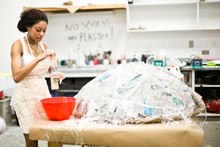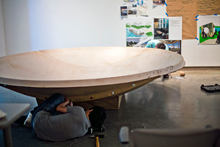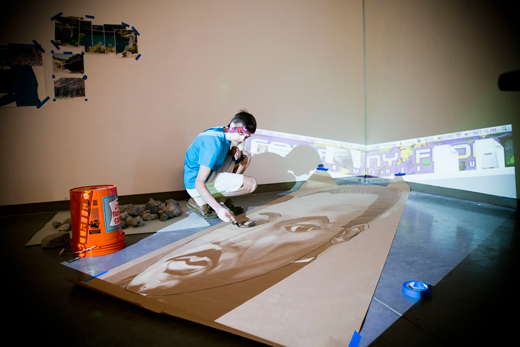Within the stillness of Emory's Visual Arts Gallery, Aidan Kim studies the yawning bowl of a discarded satellite dish — his eyes glancing at an inspirational collage of photos and sketches that paper a nearby wall.

Emory student Jeanmarie Tucker works on a paper mache ball structure for the Maymester class. Emory Photo/Video.
His vision? "MusiCube," a sphere-within-a-cube sculpture emanating light and sound that he plans to propose as a public art installation for the future Westside Reservoir Park, a 300-acre green space planned along the Atlanta BeltLine, among the city's most comprehensive revitalization efforts.
For Kim, a rising senior studying chemistry and visual arts at Emory, the project is a rare opportunity with a tangible, real-world outcome.
"Even at art schools you don't always get into practical things, like doing field research and writing a proposal for public art pieces," says Kim. "It's an unusual experience, especially for an undergraduate."
Developing and submitting an actual public art proposal is the goal behind the "Multidiscipline Design Studio" class offered through Maymester, a compressed, three-week academic term that runs from May 14-31, allowing students to intensively engage in one subject and earn up to four credit hours.
This marks the second year that Emory has offered Maymester, a program that has proven popular with students and faculty alike, says Mollie Korski, associate director of summer programs for the Office of International and Summer Programs.
This year's Maymester catalogue has grown to six courses; student enrollment jumped 20 percent over last year's inaugural session, she reports.
For students, it provides a pathway to meeting academic goals, earning college credits in a shortened semester with time left to pursue internships, summer employment or travel abroad opportunities, Korski notes.
"Maymester is a good time for students to either get ahead or catch up, to improve their GPA or maybe complete a minor," she explains.
"It's also great for faculty who want to pilot a course or work with students in a different way, such as experiential learning or community engagement," she adds.
One semester in three weeks
Launched the day after Commencement, Emory's Maymester takes full advantage of a rigorous, condensed academic format, offering class settings and structures not always available during a traditional term, according to Korski.
"The format permits an intensive learning experience, which is not always doable when students are taking three or four other courses — it's a chance to really take a particular topic to the next level," she says.
In addition to the "Multidiscipline Design Studio" class, this year's Maymester features both new and returning courses, including:
"International Shakespeare in a New Media World": Shakespearean drama is studied within a range of international and new media connections that electronically link students with faculty and lecturers from several countries.
"Writing Memory: Memoir and History": A writing course centered on human memory and personal narrative that explores the biology of memory.
"Partial Differential Equations (PDE) in Action": PDEs are used as a tool for describing real-life problems, including numerical simulations in medicine.
"The Psychology of Evil": Explores psychological research relevant to the study of "evil" behavior, including psychopathy, depravity, moral and cultural issues.
"Personality and Creativity": Examines the relationship between personality and creativity in the lives and works of creative people.
Due to the intensity of the compressed semester, students are permitted to enroll in only one Maymester course. Classes run 3.5 hours a day, along with outside reading and research, but may also feature field trips, guest lecturers or community engagement.
"At the end of the first week, one faculty member said to me, 'I've already completed a third of a semester in one week!'" Korski says. "It's like a semester on steroids."
Beyond classroom walls

Aidan Kim assembles a discarded satellite dish for use in his public art project. Emory Photo/Video.
This year, Linda Armstrong, sculptor and chair of Emory's Visual Arts Department, and Atlanta-based photographer and art educator Ruth Dusseault collaborated to create a course intended to take students well beyond traditional classroom walls.
Their "Multidiscipline Design Studio" immersed visual arts students into unfamiliar waters, including field trips to an Atlanta water works plant, lectures about fluid dynamics, hydraulics and sustainable water practices at Georgia Tech, conversations with visiting artists and the BeltLine director of design, and research into the heated politics of urban water conflicts brewing throughout the Southeast.
All of it was meant to inform their proposals for an interpretive public art installation, Armstrong says.
In three weeks, students progressed from field research to brainstorming designs, from creating prototypes to completing proposals, which will actually be presented to the Atlanta BeltLine group, she adds.
Because of the geography of the proposed Westside Reservoir Park — to be located at the site of the former Bellwood Quarry, featuring a 45-acre lake that will serve as a drinking water reservoir for Atlanta — understanding the physical, political and cultural connections of water and community was critical.
"Art is about the world, it's not just about the studio," says Dusseault, who sees within Maymester tremendous potential for universities to collaborate across boundaries in providing new perspectives and experiences.
"As an artist — or a student of anything — you need to learn how to talk to experts in other fields, ask questions and learn the definitions of a few things if you want to make art," she adds.
For Zack Mountcastle, a student at Emory's Oxford College and an Atlanta native, the design class not only offered a chance to gain credit hours, it has been a rare opportunity for community engagement — the chance to help shape something new and exciting at a site that could well become the city's largest public park.
His vision: An oversized sculpture depicting the face of Martin Luther King, Jr., shining up from beneath water within the quarry. "A nice contrast to Stone Mountain," he explains, grinning.
Editor's note: An exhibition featuring prototypes of the proposed public artwork will be on display at theEmory Visual Arts Galleryduring the first week in June.

